Question
The buzz about DDC is growing. Before negotiations with Boeing can be completed, DDC receives a buyout proposal from Silverpond Partners for $60/sh in cash,
The buzz about DDC is growing. Before negotiations with Boeing can be completed, DDC receives a buyout proposal from Silverpond Partners for $60/sh in cash, a 60% premium to the expected IPO price. Silverpond and Golib Direct Lending Fund are finalizing the terms of a $150MM Unsecured Term Loan (UTL) with an interest rate of 8%. Golib is proposing a negative covenant in the UTL that requires DDC to maintain an Fixed Charge Coverage ratio of 2.0x. The Fixed Coverage ratio is defined as: (EBITDA+Rent Exp) / (Int Exp + Rent Exp). Assuming the loan closes and funds on 1/1/20. Based on the pro-forma projection for 2020 set-forth below, what is the pro-forma Fixed Charge Coverage ratio?

A.
1.8x
B.
3.6x
C.
2.0x
D.
3.3x
E.
2.5x
Lenders often insist on Fixed Charge Coverage Covenants because:
| A. | Maximizing coverage will lower the firms WACC and improve its valuation
| |
| B. | A minimum coverage requirement will improve the firms leverage ratio
| |
| C. | Maximizing coverage will ensure lenders earn the most interest income
| |
| D. | In the event of a default, maximizing coverage will improve the lenders relative recovery compared to other pari passu claim holders
| |
| E. | Of economic volatility
|
The proposed UTL also includes a standard Restricted Payment provision (RP). Assuming the loan closes, on the day after the closing (at which point the RP basket =$0) which of the following payments would be permitted under the RP (chose all that apply):
| A loan from DDC's restricted subsidiary to DDC. | ||
| A loan from DDC's restricted subsidiary to Angel. | ||
| A payoff of a maturing bond of an unrestricted subsidiary by DDC | ||
| The repurchase by DDC of Angel's stock from his estate following his untimely death. | ||
| The repayment of a bond of a restricted subsidiary by DDC because the bond contained a covenant that limited the transferability of the subsidiary's intellectual property. | ||
| The repayment of a bond of a restricted subsidiary by an unrestricted subsidiary because the bond contained a covenant that limited the transferability of the restricted subsidiary's intellectual property. |
Step by Step Solution
There are 3 Steps involved in it
Step: 1

Get Instant Access to Expert-Tailored Solutions
See step-by-step solutions with expert insights and AI powered tools for academic success
Step: 2

Step: 3

Ace Your Homework with AI
Get the answers you need in no time with our AI-driven, step-by-step assistance
Get Started


